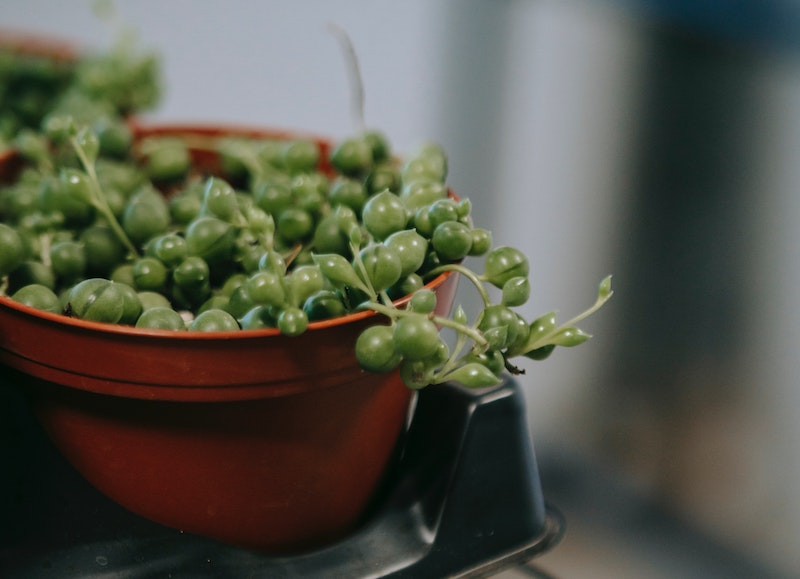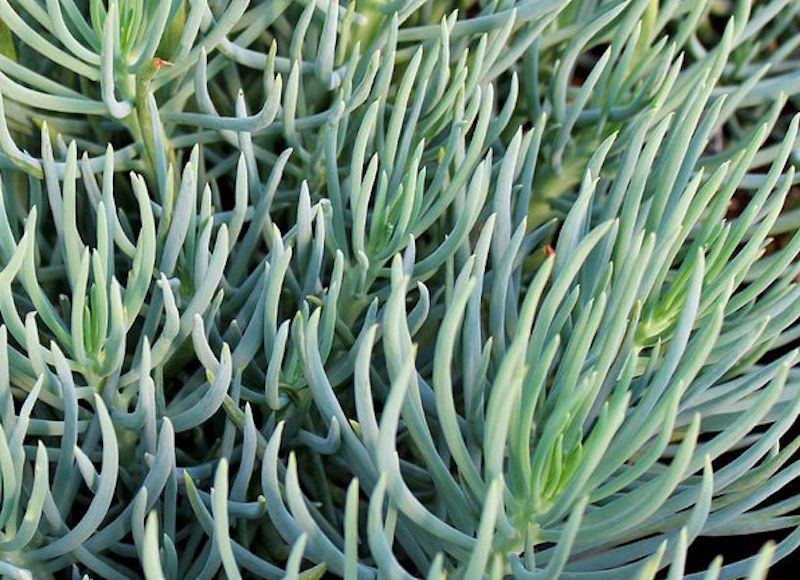Growing Senecio
Senecio is a group of plants in the Asteraceae family, all within the genus Curio. These quick-growing succulents are native to regions of South Africa, where they thrive in dry, tropical environments. They range in size from 4 inches to over 3 feet tall. Senecio is popular with growers for the diversity displayed by the members of this genus. These plants may be trailing, upright, or mat-forming, all with thick, green-to-blue, sometimes variegated, leaves. Yellow or white rounded flowers consisting of ray florets are produced.
One of the most common species of senecio for indoor growing is Curio rowleyanus, or string of pearls. This sought-after houseplant is easily recognizable by its vine-like habit, with cascading stems of rounded, pea-shaped leaves. Others, such as Curio repens, have leaves that are more erect, elongated, and stick-like, giving way to common names such as blue chalksticks. Regardless of the form, it is easy to take care of senecio to grow healthy indoor plants.

Senecio Sunlight Requirements
Senecio grows best in bright indirect to bright direct light. Some species of senecio may survive in lower light conditions, but may experience slowed growth. Many species of senecio, such as string of pearls, should be placed near east-facing windows, or several feet away from south or west-facing windows. This is because they are sensitive to bright afternoon sun, which may scorch their leaves. Other species of senecio enjoy the bright direct light that south- and west-facing windows offer, especially with proper acclimation. Place your senecio away from drafty windows, as chilly air can damage them.
Planting Senecio
Senecio thrives in sandy soils with a neutral to slightly acidic pH. Select a well-drained soil with plenty of sand for your senecio, such as a mix formulated for cacti and succulents. Plant your senecio in pots with adequate drainage holes.Terracotta or clay pots are best for planting senecio, as they allow better exchange of air and absorption of moisture to prevent root rot. For trailing species such as string of pearls, pot them in a hanging basket to allow their stems to descend down the sides of the pot. Repot your senecio every 2-4 years, depending on the species and rate of growth. Size up to a pot that is 1-2 inches wider than the diameter of the plant’s root system.
Watering Senecio
Senecio plants are succulents that are able to survive long periods of time without water. Only water your senecio every 1 to 2 weeks, less in the winter months. Water the plant until excess liquid leaves the drainage holes, and empty the water from the drainage tray. Allow your senecio to completely dry out in between watering. Wrinkled leaves are a common sign of underwatering, while mushy, leaking leaves are a common sign of overwatering. Senecio plants are especially susceptible to overwatering, so pay attention to any signs of root rot.

Fertilizing Senecio
Senecio does not require frequent fertilization. These plants are native to regions with nutrient-poor soils, so it is much easier to over-fertilize than to under-fertilize them. Too much fertilizer may result in elongated, weak growth. If necessary, senecio can be fertilized just once per year during the active growing seasons of spring and summer. Select a low-strength fertilizer formulated for cacti and succulents, or dilute a stronger houseplant formulation to half-strength. If symptoms of excess nutrients such as leaf burn or leggy growth appear, repot your senecio in fresh soil and prune off any damaged leaves or spindly stems.
Common Senecio Problems
Squishy, yellow, or wrinkled leaves with leaf drop are often caused by problems with watering or temperature. Check the soil moisture, and water or repot if needed. Make sure your senecio is growing in a warm, bright location. In case of root rot, prune off all dead, rotted leaves, stems, and roots, and repot in fresh, quick-draining soil immediately. Let the plant dry out for a couple weeks before watering. You can also simply propagate the plant from any healthy remaining leaves or stems.
Senecio is not particularly prone to many pests or diseases. Occasionally, they may become hosts for common houseplant pests, such as scale and mealybugs. Treat with a horticultural oil diluted per label instructions, covering all parts of the plant. If your senecio is not flowering, it can be prompted to flower by initiating a dormancy period. To do this, place it in a cooler location throughout winter and reduce watering significantly. Once spring arrives, make sure it has bright light and fertilize it lightly.
Propagating Senecio
Senecio can be propagated from stem and leaf cuttings. Remove a healthy leaf or a stem with clean, sterile scissors. If taking a stem cutting, make sure that it is at least 3-5 inches long with at least one or two nodes. Remove all of the lower leaves, retaining those towards the top of the cutting. Allow the stem or leaf cutting to callus over for several days in a dry location. Dip the cut end in rooting hormone if desired. Next, plant the cutting in a tray filled with cacti potting mix. Water it only when the soil is completely dry, and repot once the plants are fully rooted.

Growing Senecio Outdoors
Senecio is a perennial in USDA zones 9-12, growing best in temperatures of 70-80°F. When planted in the ground, many species of senecio make excellent ground covers in sandy soils. These plants are drought tolerant and only need to be watered in extremely dry outdoor conditions. Place your senecio in full to partial sun. The colder the temperature, the more sunlight senecio can handle. Acclimate your plant outside by exposing it to direct sun for a few hours at a time, gradually increasing exposure time with the passing days or weeks. Senecio gets its name from the former genus it was classified in, Senecio, now Curio. Several species of the genus Senecio, called ragworts, are native to temperate locations worldwide. These closely related plants can be grown outdoors in colder regions year-round.
 |
Lauren Youngcourt - Published 03-03-2023 |
